Last summer, 2004, Ruel A Macaraeg visited the workshop of Armour Class, in Glasgow,Scotland !
The reasons for his visit was twofold ....
Firstly, to purchase one of their fine claidheamh dà làimh (which is a beautiful recreation of a classic 16th century two-hander) and secondly, to meet some of the talented craftspeople behind the hammers, while getting a firsthand look at the workshop where these fine products are made!
Ruel snapped the following 11 images ..... I will let him fill in the details, or answer any questions concerning them !
Alba gu brath, Mac
Last edited by Thomas McDonald on Fri 09 Sep, 2005 7:25 pm; edited 2 times in total
continued .....
Last edited by Thomas McDonald on Fri 09 Sep, 2005 7:22 am; edited 4 times in total
This only makes me want to have my Armourclass Cup and Ring baskethilt even more. :D
Great to see the workshops where all their swords are made. Very nice.
*sigh* Only a few more weeks........ :)
Great to see the workshops where all their swords are made. Very nice.
*sigh* Only a few more weeks........ :)
This is an interesting pic, as it shows their construction method on a few different basket-hilt types !
Looks like they cut out a pattern ( or it's punched out ?) and basically fold it up and weld, rather than assemble alot of sperate components !
Mac
Looks like they cut out a pattern ( or it's punched out ?) and basically fold it up and weld, rather than assemble alot of sperate components !
Mac
| Thomas McDonald wrote: |
| This is an interesting pic, as it shows their construction method on a few different basket-hilt types !
Looks like they cut out a pattern ( or it's punched out ?) and basically fold it up and weld, rather than assemble alot of sperate components ! |
Mac,
That's true. I outlined the process a bit in my AC Cup and Ring basket hilt review.
| Quote: |
| Allan was kind enough to detail the process for me: "There are no castings in the basket-hilt you have. The pattern is cut into 4mm sheet steel and all the edges are ground to shape, filed and sanded. The Saltire lines are ground in with a Dremel type of tool, the cup and ring marks are hot forged in with a die I turned on the lathe (small Colchester Student lathe). Areas of the hilt are heated yellow hot and hammered over profiled dollies to bring the basket into shape. Once this has been finalized, some of the areas are welded together and the sword catchers are welded in place. The whole hilt is then re-ground to shape, filed and sanded to the final finish." |
Hi Chad
Thanks for that, I'd forgotten !
I guess I never really got a grasp of their process until I saw that photo ..... interesting !
I know Donnie Shearer said he had a sheet pattern for a Drury regimental style hilt, perhaps he does something similar to what AC is doing on that one ?
Thanks again, Mac
Thanks for that, I'd forgotten !
I guess I never really got a grasp of their process until I saw that photo ..... interesting !
I know Donnie Shearer said he had a sheet pattern for a Drury regimental style hilt, perhaps he does something similar to what AC is doing on that one ?
Thanks again, Mac
| Chad Arnow wrote: |
| Mac,
That's true. I outlined the process a bit in my AC Cup and Ring basket hilt review. |
Mac,
Thanks a bunch fo posting these! To see the birth-place of "my precious" is grand. and come to think of it, if these were taken "last summer", one of those Mort. hilts on the bottom shelf ,could've been mine in the making. One-day, when we get back over there, this is one place I must stop-into to view for myself.
That two-hander is quite brilliant as well!
Bill
Thanks a bunch fo posting these! To see the birth-place of "my precious" is grand. and come to think of it, if these were taken "last summer", one of those Mort. hilts on the bottom shelf ,could've been mine in the making. One-day, when we get back over there, this is one place I must stop-into to view for myself.
That two-hander is quite brilliant as well!
Bill
| William Goodwin wrote: |
| Mac,
Thanks a bunch fo posting these! To see the birth-place of my precious is grand. One-day, when we get back over there, this is one place I must stop-into view for myself. That two-hander is quite brilliant as well! Bill |
Yer welcome, laddie ..... but the real thanks goes to Ruel !
I'm hoping to get the original high-res images from him so I can bring up the details !
* I'll also be adding these to the Album section once I have Ruel's commentary on 'em !
Pretty cool seeing all those baskets on the shelf there, 'eh William (Yup, Mort's are there too ;-)
I'll be roaming the streets of Glasgow very soon, myself, Lord willing !
* About a month from now, so you've been warned Scotland :-) Mac
Thanks for the "inside scoop", Mac and Ruel!
I have a couple AC swords myself -- a Stirling-style "Wave-Hilt" backsword and a Stirling-style "Diamond-hilt" broadsword. They are not as finely detailed as a Vince Evans or Eljay Erickson, but they are very nice swords -- probably the best production (or more accurately, semi-production) Scottish basket hilts on the market currently.
My "Wave" hilt is a bit hefty for what it is, but it is very finely balanced, with a feel I'd describe as "precise". The Diamond hilt is better in terms of weight and in just very sweet to handle.
I have a couple AC swords myself -- a Stirling-style "Wave-Hilt" backsword and a Stirling-style "Diamond-hilt" broadsword. They are not as finely detailed as a Vince Evans or Eljay Erickson, but they are very nice swords -- probably the best production (or more accurately, semi-production) Scottish basket hilts on the market currently.
My "Wave" hilt is a bit hefty for what it is, but it is very finely balanced, with a feel I'd describe as "precise". The Diamond hilt is better in terms of weight and in just very sweet to handle.
Thanks Mac for getting the pix up -- and for your constant enthusiasm! -- and for everyone else's kind words. Let's see if we can make some sense of these shots; I'll try to put them in order as I took them.
The Armour Class workshop is in an industrial park on the western outskirts of Glasgow; you'd never find it if you didn't know exactly where to go! I suppose craftsmen need that kind of solitude to work. This is Ian, who showed me around the shop. Here he's demonstrating the flexibility of a newly tempered blade:
[ Linked Image ]
The blades get dunked in these three vats. I believe one is water, one is an oil quench, and the last for cryogenic tempering:
[ Linked Image ]
I can't recall what this is, but hopefully one of our resident makers will recognize it:
[ Linked Image ]
As noted above, these are templates for Scottish baskethilts.
[ Linked Image ]
Baskethilts and other complex hilts including clamshells and pappenheimers awaiting their cutlers:
[ Linked Image ]
Blade blanks. Ian said that most of their orders actually go to various live steel groups in the UK, some of whom even do sharpened sparring. According to him, Armour Class doesn't encourage this, but simply accepts it as the state of the market and adjusts production accordingly.
[ Linked Image ]
Some assembled swords: Clam/cuphilt rapier, shortsword mounted as a cuphilt, swepthilt rapier, Viking sword, main gauche, another clamshell with its main gauche, and a baskethilt (spadroon?). All handled nicely.
[ Linked Image ]
More finished swords; the Gilling at the end was particularly nice.
[ Linked Image ]
The one on the right is actually a saber with a shallow curve. This was probably the most interesting piece I handled there; too bad its not listed on the AC website because, given the fad for Euro-sabers currently taking hold, I'm sure it'd be on many short lists!
[ Linked Image ]
Sporrans and other tooled leatherwork. The baskethilts in front have a browned finish that looks pretty nice.
[ Linked Image ]
The Armour Class workshop is in an industrial park on the western outskirts of Glasgow; you'd never find it if you didn't know exactly where to go! I suppose craftsmen need that kind of solitude to work. This is Ian, who showed me around the shop. Here he's demonstrating the flexibility of a newly tempered blade:
[ Linked Image ]
The blades get dunked in these three vats. I believe one is water, one is an oil quench, and the last for cryogenic tempering:
[ Linked Image ]
I can't recall what this is, but hopefully one of our resident makers will recognize it:
[ Linked Image ]
As noted above, these are templates for Scottish baskethilts.
[ Linked Image ]
Baskethilts and other complex hilts including clamshells and pappenheimers awaiting their cutlers:
[ Linked Image ]
Blade blanks. Ian said that most of their orders actually go to various live steel groups in the UK, some of whom even do sharpened sparring. According to him, Armour Class doesn't encourage this, but simply accepts it as the state of the market and adjusts production accordingly.
[ Linked Image ]
Some assembled swords: Clam/cuphilt rapier, shortsword mounted as a cuphilt, swepthilt rapier, Viking sword, main gauche, another clamshell with its main gauche, and a baskethilt (spadroon?). All handled nicely.
[ Linked Image ]
More finished swords; the Gilling at the end was particularly nice.
[ Linked Image ]
The one on the right is actually a saber with a shallow curve. This was probably the most interesting piece I handled there; too bad its not listed on the AC website because, given the fad for Euro-sabers currently taking hold, I'm sure it'd be on many short lists!
[ Linked Image ]
Sporrans and other tooled leatherwork. The baskethilts in front have a browned finish that looks pretty nice.
[ Linked Image ]
I forgot I had this picture! This is my claymore, held by a fine Scottish gentleman who's the managing technician for several buildings on the Glasgow University campus. He's probably about 5'9", to give some frame of reference. Despite my best efforts to hide it, the box was too big not to attract the notice of my fellow conference delegates and I had to let them all have a few swings with the sword. :)
[ Linked Image ]
OK! Hopefully more to come from the Hunterian Museum. Thanks for letting me share, if a little late.
[ Linked Image ]
OK! Hopefully more to come from the Hunterian Museum. Thanks for letting me share, if a little late.
Hi Ruel
Thanks for letting us know the scoop on those photos .... much appreciated !
(I will add them to the Album section, unless you wish to ?)
Okay, next I will attach some of the photos Ruel took at the Hunterian Museum & Art Gallery , Glasgow .
Again, I'll let Ruel comment on what he shot !
* I do recognize that targe, though .....
It is know as the earliest dated targe, MacKay, which has '1623' engraved on its brass boss .
Mac
 Attachment: 52.89 KB
Attachment: 52.89 KB
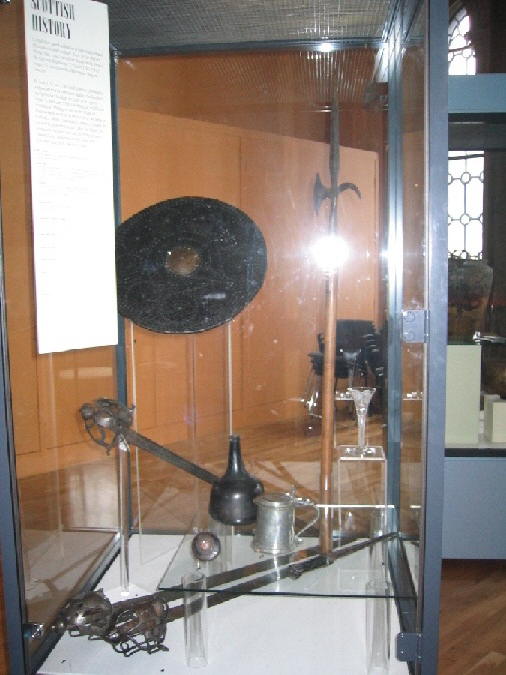
 Attachment: 50.81 KB
Attachment: 50.81 KB

 Attachment: 62.08 KB
Attachment: 62.08 KB
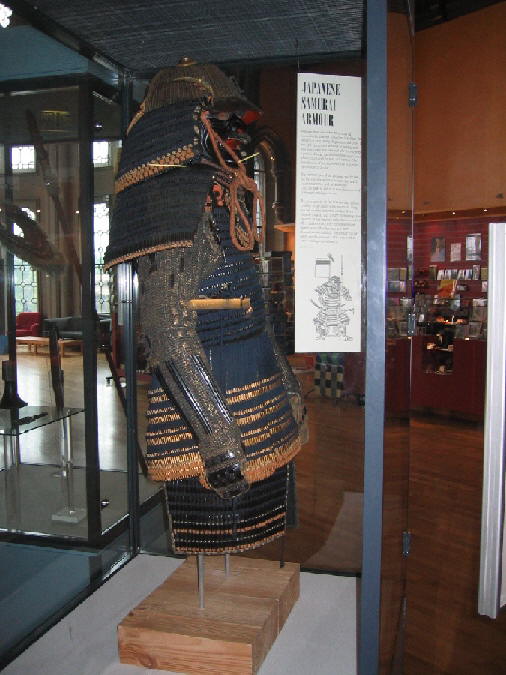
 Attachment: 65.63 KB
Attachment: 65.63 KB
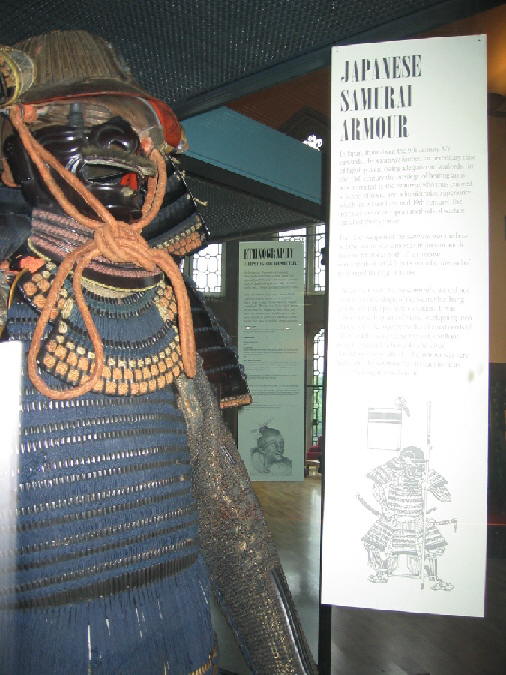
 Attachment: 51.71 KB
Attachment: 51.71 KB
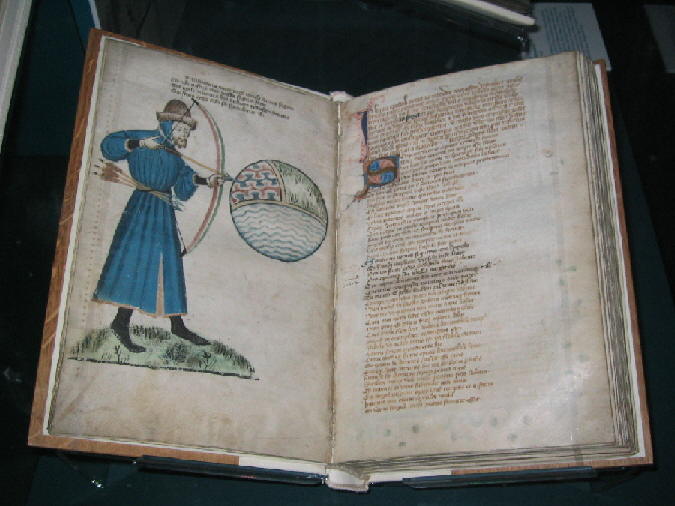
 Attachment: 41.56 KB
Attachment: 41.56 KB
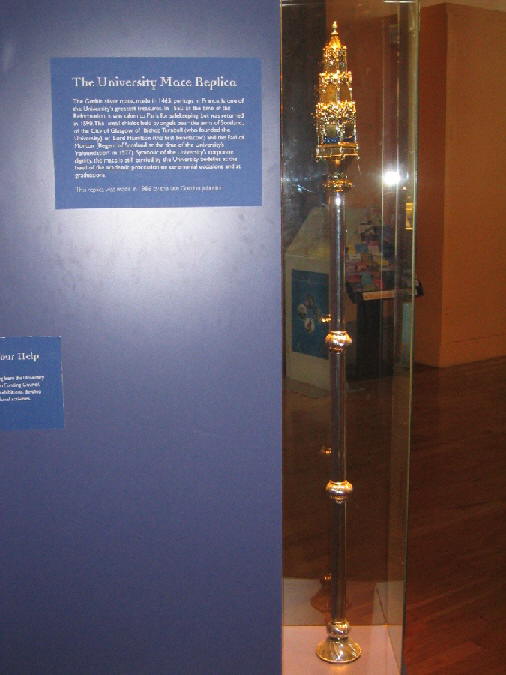
 Attachment: 40.69 KB
Attachment: 40.69 KB

 Attachment: 55.32 KB
Attachment: 55.32 KB

Thanks for letting us know the scoop on those photos .... much appreciated !
(I will add them to the Album section, unless you wish to ?)
Okay, next I will attach some of the photos Ruel took at the Hunterian Museum & Art Gallery , Glasgow .
Again, I'll let Ruel comment on what he shot !
* I do recognize that targe, though .....
It is know as the earliest dated targe, MacKay, which has '1623' engraved on its brass boss .
Mac








| Quote: |
| (I will add them to the Album section, unless you wish to ?) |
Be my guest -- I may have a "Mac-" in my name, but you're the real Scotsman! :cool: Plus, they still don't seem to be uploading to the albums from my end...(?)
The Hunterian was actually closed at the time for renovation, but I was able to get in as I was a guest of the university for a conference. :) Still, they only gave me 15 minutes -- I went in while the work crew was on a smoke break -- so I had to rush!
OK: The present site of Glasgow U only dates to the late 1800s, but the former site was a staging point for the Hanoverians throughout the whole Jacobite period. As such, it accumulated several contemporary arms and armor pieces, some of which are now on display at the Hunterian. Mac already identified the targe and baskethilts; the polearm's haft was apparently cut down. The dagger looks to me more like a Continental ballock than the more distinctly Scottish dirk.
[ Linked Image ]
[ Linked Image ]
Has anyone else wondered at the large number of Japanese armors in Britain? I didn't expect to find this one here, not to mention the case full at the Royal Museum in Edinburgh. Leeds of course has tons. This one has a lamellar cuirass instead of the more typical plate.
[ Linked Image ]
You should be able to read the caption here. There were commencement ceremonies going on at the same time I was there, and I think the actual mace was being paraded about during all the pomp and circumstance.
[ Linked Image ]
Some LaTene period Celtic stuff. I apologize for the glare:
[ Linked Image ]
The Gallery was preparing an exhibit on illuminated manuscripts, and I thought this would be of interest because it depicts an archer. Notice how he doesn't use a quiver, but simply tucks his arrows into a belt -- was this normal?
[ Linked Image ][/img]
Here are a couple extra. These were acquired during the Captain Cook voyages. As you may know, Joseph Banks, the independently wealthy science officer on one of the expeditions who provided much of the financing, later fell out with the Royal Society. Instead of giving his acquisitions to them, he distributed them among his friends, one of whom was the eponymous Hunter (then of the Royal College of Physicians). These form the backbone of the Hunterian's historical and biological collections.
These two are Maori, from New Zealand: a maripi 'human skinner' fleshing knife/weapon with lashed shark's teeth, and a taiaha fighting staff.
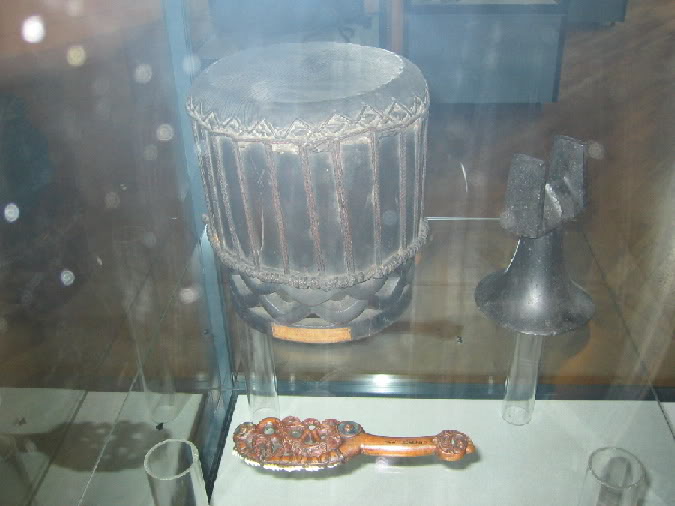
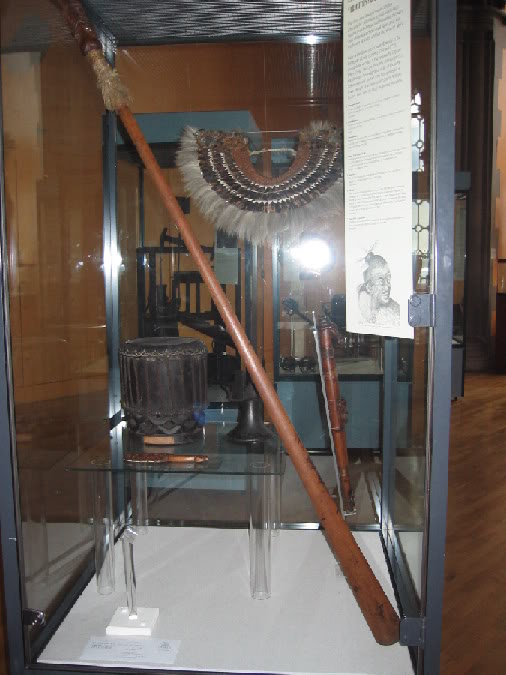
This is a Haida whalebone club (NWCoast Indians):
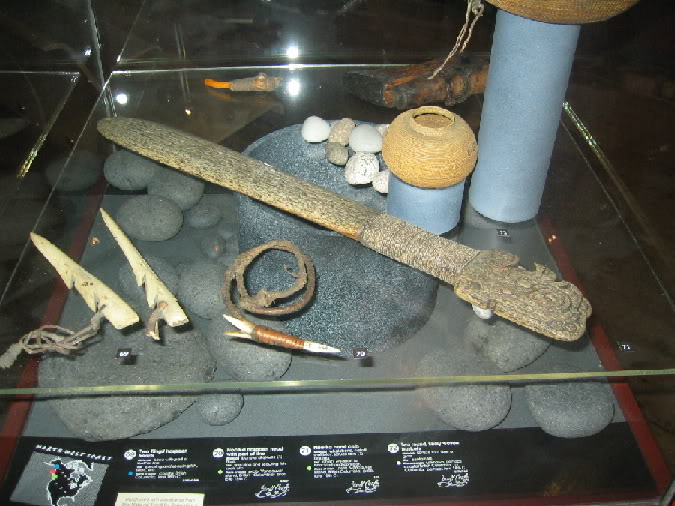
These are Eskimo knives of walrus ivory.
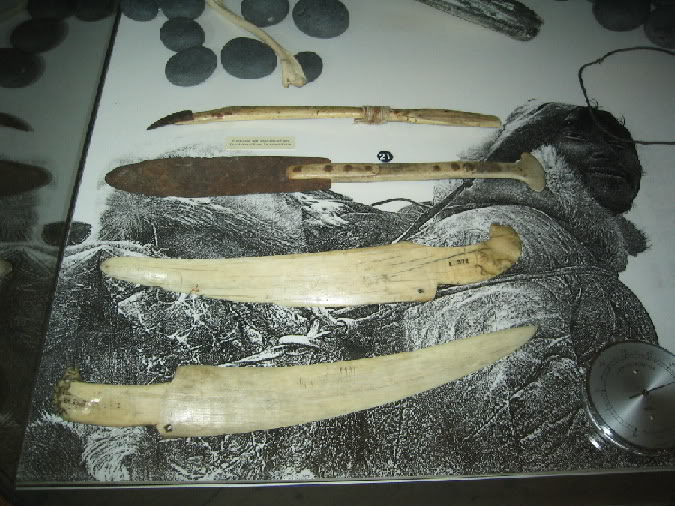
Finally, a lorica segmentata. The captions on this weren't up, so I don't know if it's an original, a restored original, or a replica.

These two are Maori, from New Zealand: a maripi 'human skinner' fleshing knife/weapon with lashed shark's teeth, and a taiaha fighting staff.


This is a Haida whalebone club (NWCoast Indians):

These are Eskimo knives of walrus ivory.

Finally, a lorica segmentata. The captions on this weren't up, so I don't know if it's an original, a restored original, or a replica.

Page 1 of 1
You cannot post new topics in this forumYou cannot reply to topics in this forum
You cannot edit your posts in this forum
You cannot delete your posts in this forum
You cannot vote in polls in this forum
You cannot attach files in this forum
You can download files in this forum
All contents © Copyright 2003-2006 myArmoury.com — All rights reserved
Discussion forums powered by phpBB © The phpBB Group
Switch to the Full-featured Version of the forum
Discussion forums powered by phpBB © The phpBB Group
Switch to the Full-featured Version of the forum